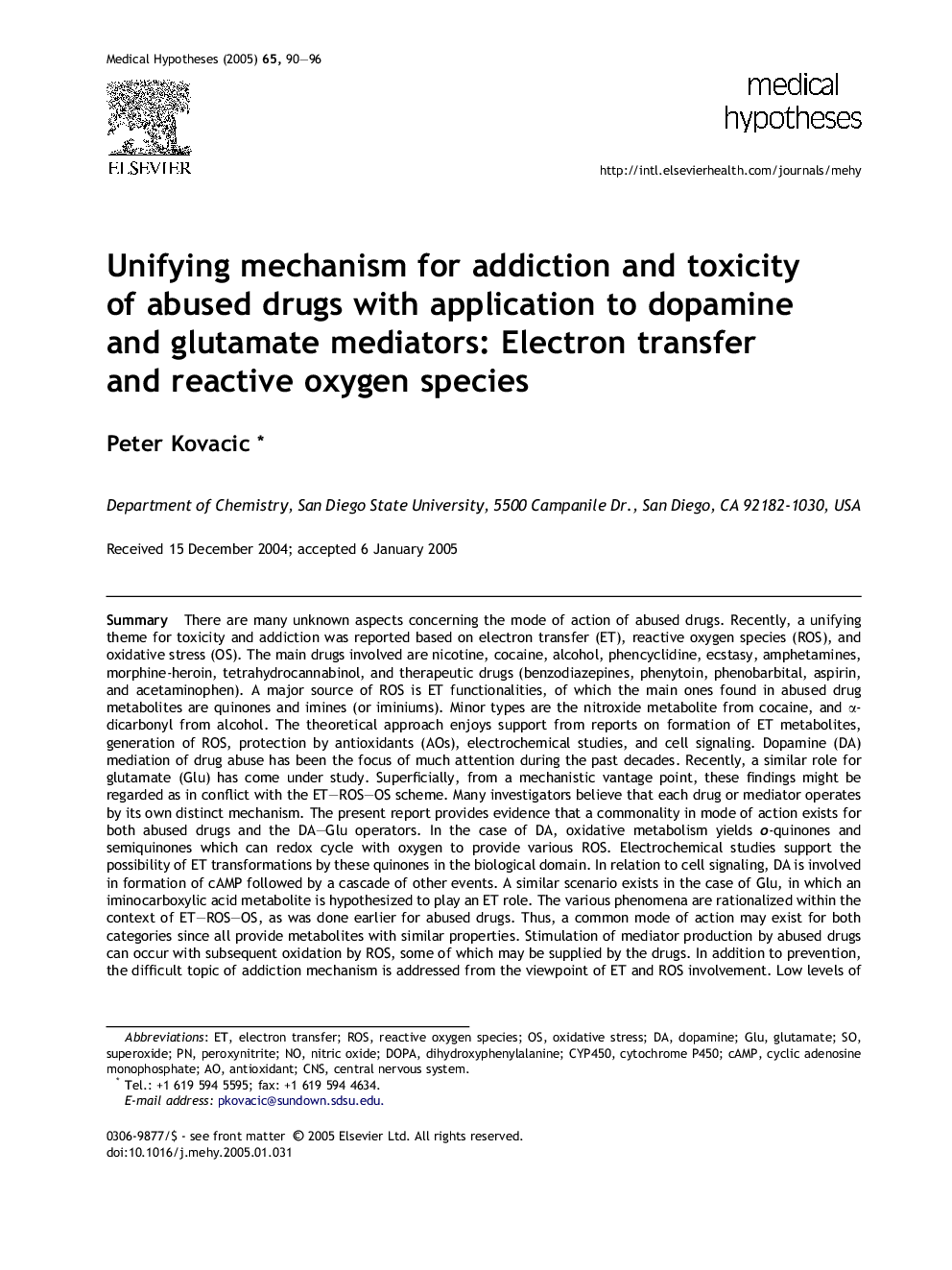| کد مقاله | کد نشریه | سال انتشار | مقاله انگلیسی | نسخه تمام متن |
|---|---|---|---|---|
| 8995837 | 1115106 | 2005 | 7 صفحه PDF | دانلود رایگان |
عنوان انگلیسی مقاله ISI
Unifying mechanism for addiction and toxicity of abused drugs with application to dopamine and glutamate mediators: Electron transfer and reactive oxygen species
دانلود مقاله + سفارش ترجمه
دانلود مقاله ISI انگلیسی
رایگان برای ایرانیان
کلمات کلیدی
CYP450DOPAcAMP - cAMPROS - ROSCyclic adenosine monophosphate - آدنوزین مونوفسفات CyclicAntioxidant - آنتی اکسیدانelectron transfer - انتقال الکترونOxidative stress - تنش اکسیداتیوCNS - دستگاه عصبی مرکزیDopamine - دوپامینdihydroxyphenylalanine - دی هیدروکسی فنیل آلانینSuperoxide - سوپر اکسیدCytochrome P450 - سیتوکروم پی۴۵۰central nervous system - سیستم عصبی مرکزیNitric oxide - نیتریک اکسیدPeroxynitrite - پروکسی نیتریتGlu - گلوglutamate - گلوتاماتReactive oxygen species - گونههای فعال اکسیژن
موضوعات مرتبط
علوم زیستی و بیوفناوری
بیوشیمی، ژنتیک و زیست شناسی مولکولی
زیست شناسی تکاملی
پیش نمایش صفحه اول مقاله

چکیده انگلیسی
There are many unknown aspects concerning the mode of action of abused drugs. Recently, a unifying theme for toxicity and addiction was reported based on electron transfer (ET), reactive oxygen species (ROS), and oxidative stress (OS). The main drugs involved are nicotine, cocaine, alcohol, phencyclidine, ecstasy, amphetamines, morphine-heroin, tetrahydrocannabinol, and therapeutic drugs (benzodiazepines, phenytoin, phenobarbital, aspirin, and acetaminophen). A major source of ROS is ET functionalities, of which the main ones found in abused drug metabolites are quinones and imines (or iminiums). Minor types are the nitroxide metabolite from cocaine, and α-dicarbonyl from alcohol. The theoretical approach enjoys support from reports on formation of ET metabolites, generation of ROS, protection by antioxidants (AOs), electrochemical studies, and cell signaling. Dopamine (DA) mediation of drug abuse has been the focus of much attention during the past decades. Recently, a similar role for glutamate (Glu) has come under study. Superficially, from a mechanistic vantage point, these findings might be regarded as in conflict with the ET-ROS-OS scheme. Many investigators believe that each drug or mediator operates by its own distinct mechanism. The present report provides evidence that a commonality in mode of action exists for both abused drugs and the DA-Glu operators. In the case of DA, oxidative metabolism yields o-quinones and semiquinones which can redox cycle with oxygen to provide various ROS. Electrochemical studies support the possibility of ET transformations by these quinones in the biological domain. In relation to cell signaling, DA is involved in formation of cAMP followed by a cascade of other events. A similar scenario exists in the case of Glu, in which an iminocarboxylic acid metabolite is hypothesized to play an ET role. The various phenomena are rationalized within the context of ET-ROS-OS, as was done earlier for abused drugs. Thus, a common mode of action may exist for both categories since all provide metabolites with similar properties. Stimulation of mediator production by abused drugs can occur with subsequent oxidation by ROS, some of which may be supplied by the drugs. In addition to prevention, the difficult topic of addiction mechanism is addressed from the viewpoint of ET and ROS involvement. Low levels of ROS would pertain since high concentrations are related to toxicity. A report that tetrahydrocannabinol does not comprise a substantial risk is in accord with little evidence of OS and absence of ET functionalities in the drug and reported metabolites.
ناشر
Database: Elsevier - ScienceDirect (ساینس دایرکت)
Journal: Medical Hypotheses - Volume 65, Issue 1, 2005, Pages 90-96
Journal: Medical Hypotheses - Volume 65, Issue 1, 2005, Pages 90-96
نویسندگان
Peter Kovacic,